Saturday, 6 August 2005
Amazing Animals: The Sturgeon
(No. 4 in my series)
Now Playing: The Song of Hiawatha
Topic: Nature and Our World
My father once gave me a beautifully illustrated leather-bound book of
Henry Wadsworth Longfellow's poems. It was old and the cover was falling apart but I took it to school as we were studying poetry in the sixth form. Stupidly, I allowed myself to be persuaded to lend it to another girl towards the end of term - and that was the last I ever saw of my book! I particularly loved, "The Song of Hiawatha", and that was where I first learnt about the sturgeon, that most ancient of fishes:-
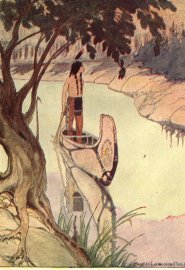 | On the white sand of the bottom
Lay the monster Mishe-Nahma,
Lay the sturgeon, King of Fishes;
Through his gills he breathed the water,
With his fins he fanned and winnowed,
With his tail he swept the sand-floor.
There he lay in all his armor;
On each side a shield to guard him,
Plates of bone upon his forehead,
Down his sides and back and shoulders
Plates of bone with spines projecting
Painted was he with his war-paints,
Stripes of yellow, red, and azure,
Spots of brown and spots of sable;
And he lay there on the bottom,
Fanning with his fins of purple,
As above him Hiawatha
In his birch canoe came sailing,
With his fishing-line of cedar.
|
Hiawatha's 'Mishe-Nahma' was the North American
Lake Sturgeon (
Acipenser fulvescens) which, despite its name is actually a river fish. Found mainly in Lakes Michigan, Huron, Ontario, Erie and Superior, it once ranged widely throughout the Mississippi River, the Great Lakes and the Hudson River. Gelatine from its swim bladder was used in the past for making
isinglass, a semi-transparent substance which was widely employed commercially for clarifying jams, jellies and alcoholic drinks, as a size for handmade paper and in the making of isinglass windows for carriages and early cars. Its skin was made into leather and its meat and eggs sold commercially.
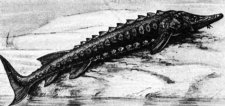
Sturgeon belong to the order of
Acipenseriforms, family
Acipenseridae. There are twenty-seven living species - all in the Northern Hemisphere and all in serious decline. According to
WildAid, only three of the species is not
critically endangered or
endangered due to the demand for caviar. This is a sad state of affairs as, together with their cousins, the Paddlefish, Sturgeon are the only survivors of an ancient group of fishes from the Upper Cretaceous period (135-200 million years ago) which, with five extinct species, formed the infraclass
Chondostrei. These ancient 'living fish fossils' are, therefore, one of the oldest vertebrates on Earth. The sturgeon is also the largest of freshwater fishes and the longest lived. The greatest recorded age was 154 years for a Lake sturgeon caught in 1953.

Some Sturgeon live in the sea but migrate to freshwater to breed (anadromous) and others live entirely in freshwater. These primitive fish have an almost entirely cartilaginous endoskeleton with a flexible cartilaginous rod called a notochord running down the back instead of a backbone. They have heavy tube-like bodies with five rows of large bony plates or scutes along their sides instead of scales and, in common with many other primitive fish, they have an asymmetrical (heterocercal) caudal fin or tail.
Sturgeon have short, highly sensitive fleshy barbels on their slightly flattened upturned snouts which they use to find a wide variety of food including insect larvae, bottom-dwelling worms, shrimp, small fish and molluscs such as crayfish, clams, and snails. These are sucked up through their large toothless mouths which they can extend into a funnel-shape. Both anadromous and freshwater species cease feeding during the spawning season. It takes a long time, anything between 8-25 years (depending on the species), for females to reach sexual maturity and then spawning will only occur every 2-4 years or more. Their slow growth and infrequent spawning make it extremely difficult for this animal to recover from decline. Together with over-fishing and degradation of habitat, this is one of the reasons why these amazing fish have become so endangered. When they do spawn, eggs are produced in millions - some three million in the Atlantic sturgeon and up to seven million in the Beluga sturgeon. The eggs are highly adhesive and attach to vegetation or stones. Hatching takes about one week. Growth is probably quite rapid for the first five years providing the hatchlings survive, which not many do.
The Beluga (
Huso husa), is found principally in the Caspian Sea with spawning occurring mainly in the Volga River and also in the Black, Azov, and Adriatic Seas, as well as the Dnepr and Danube rivers. However, access to the old spawning grounds has been blocked since the building of the Volgograd Dam, (
note: from 1925-61, Volgograd was known as Stalingrad). Beluga can live up to 100 years or more and it is the largest sturgeon in the world, and probably the most famous because its roe (unfertilized eggs) is highly prized as caviar. Beluga can reach lengths up to 30 feet and can weigh up to 2000 pounds; one fish, caught in 1926, weighed 2,200lbs (over 1,000kg) and yielded 396lb (180kg) of caviar - it was estimated to be at least 75 years old. Nowadays, fish are much smaller because the 'old' population has been exterminated by over-fishing and poaching.
Without commercial hatcheries, the Beluga would probably be extinct today. Interestingly, some aquaculturists have been developing methods to surgically remove eggs without killing the fish - a piscine 'caesarean'! However, many fish still die after this operation and more research is needed. I hope you don't eat caviar but, if you must, then please purchase your supply from an outlet which supports
conservation and ecologically sound harvesting.
Tuesday, 12 July 2005
Animal Intelligence
Now Playing: Talk to the Animals
Topic: Nature and Our World
I've always believed that animals are far more intelligent than people give them credit for, especially the mammals and the birds. Well, how could animals have survived for many hundreds of thousands of years before the dawn of man if they weren't clever and resourceful? But do they actually think and plan, are they aware of self and can they communicate with each other? Many trained animals seem to exhibit signs of intelligence comparable with a three or four year old child! So, for instance, how long does it take a
child to realise that the image in a mirror is their own reflection? Well, about two years apparently. So it is not surprising that
some animals, such as dolphins, definitely recognise themselves in a mirror and that dogs and wolves have a very strong sense of family.
Do animals think and plan? Well, this story I read once about a horse indicates that they can. The horse belonged to a farmer who kept him in a field about ½ mile away from the farmhouse. One night, the farmer was woken up by the horse neighing outside his bedroom. It was pouring with rain so an annoyed farmer had to put on wellies and a raincoat over his pyjamas and lead the horse back down the lane. When they arrived at the field, the farmer heard a strangled "MOO". The cow in the field next door had caught her horns in the fence and, in her struggles to get free, had fallen upside down - she would not have lasted the night. So, did the horse know he had to get help and that he had to jump out of the field and run up to the farmhouse? I think he did!
We talk of 'bird-brained' as a derogatory adjective but just because birds have a different type of brain doesn't mean it is inferior to that of mammals. My late sister, Pauline, once owned a pet Brazilian Hangnest. He was very tame and I can remember laughing when I showed him a mirror and he started to display to his image. I also showed him a book with a picture of a Hangnest. But he was a wise little bird and he craned his little head and looked behind the book. He may not have been aware of self but, he had realised very quickly that it was not another bird and from then on he stopped displaying.
Without doubt, one of the most intelligent birds is the parrot. And now a scientist undertaking research with an
African Grey Parrot called Alex, has shown that he understands the abstract concept of zero and correctly used the word 'none' to describe an absence of objects.
Alex can count, understands colours and shapes and has a large vocabulary. He can also get bored and irritated and refuse to answer,
"No!", "Want corn!", just like a small petulant child. Another grey parrot called,
N'kisi can use and apparently understand over 700 words and has an affinity for telepathy!
Teaching animals to mimic the human way of communication does not necessarily mean they have language skills in the wild although I believe many do. Take the Gorilla,
Koko, who has learnt sign language. She has told her keepers she wants a baby! I remember seeing a TV programme about her a long time ago. It was sad because she was shown lots of pictures of male gorillas in zoos and she picked the one she fancied! However, when he arrived, he did not show any interest in poor old Koko! So, she mothers tiny kittens instead. Then there is the chimpanzee,
Washoe and her friends. Washoe was taught signing and soon began to combine the signs into meaningful phrases, "
You me hide", "
You me go out hurry". When other chimpanzees were included in the study, they starting signing amongst themselves, even when on their own, and they taught signing to another chimp and adapted the signs for their own use. They were definitely talking to each other.
Scientists are just beginning to understand animal communication and I remember yet another TV documentary about Prairie Dogs. (You will know by now that I enjoy watching nature programmes on telly!) The
scientist studying these little creatures tapes their squeaks and grunts, which sound all the same to our ears. He then analyses the sounds on his computer and creates a sonogram, or visual representation of the sound waves. It seems that the prairie dogs have a rudimentary
language as he discovered that the little creatures had 'words' for various predators and for other animals such as deer or cows. They also had words for 'tall man' and 'short man' and they even added a sound to tall man to indicate he was wearing a red t-shirt. Amazing!
Perhaps, one day there will be a real
Dr Dolittle who really can talk to the animals.
Monday, 27 June 2005
Amazing Animals: The Emperor Penguin
(No. 3 in my series)
Topic: Nature and Our World

I've always been fascinated by that most marine of birds, the
penguins, an ancient branch of the animal kingdom. Ancestral penguins were well established some 50 million years ago, which probably makes them one of the oldest of the class of Aves (birds). All penguins belong to the order Sphenisciformes, a term which refers to their narrow, flipper-like wings. The word comes from the Greek,
spheniskos, meaning 'a small wedge'. Unlike other birds, penguins can't fold their 'wings' because their elbow joint is fixed. The flipper only moves at the shoulder joint - an adaptation which gives them more power when 'flying' through the water. They are also unique amongst birds because, apart from a brief appearance of wing quills early in the embryonic stage, they do not have any flight feathers on their wings. Their large, webbed feet and their tails are used as rudders enabling them to 'dart' about with amazing agility when chasing fish or shrimps. Their unusual beak structure, formed of several layers of horny plates, indicates a distant relationship to the albatross. However, without doubt, they are the champion swimmers and divers amongst all sea birds.
On land (or ice), penguins are rather comical creatures because they are handicapped by their extremely short legs, which are set far back on their chunky streamlined bodies. They are forced to stand upright and hop or waddle along. This make them appear 'human-like' and they have been compared to nuns dressed in a black and white habit or to men in evening dress! Actually, penguins can move very fast on icy ground by falling down and tobogganing along using their feet. It is said that they can go faster this way than a man on skis.
Scientists have recognised at least 32 species of extinct penguins, some of them quite large.
Anthropornis of the South Orkneys and
Palaeudyptes of New Zealand stood more than five feet tall. Today, there are about 17 species of penguin alive although some scientists classify the white-flippered variety of fairy penguin,
Eudyptula albosignata, as an 18th variety. Of these, the most amazing species for me is the
Emperor Penguin,
Aptenodytes forsteri. It is the largest and tallest of the penguins with males reaching some 4 feet in height. Did you know that Emperor penguins are capable of swimming underwater at up to 37 miles per hour propelled by their strong flippers - a speed which rivals that of seals and porpoises? They can also dive up to 870 feet and remain submerged for up to 18 minutes.
For their first three or four years until they reach maturity, the Emperor penguins spend their time feeding in the krill-rich waters off the coast of Antarctica. Their preferred food is fish and squid. Emperor penguin's breed every year and their breeding cycle begins in March, autumn in the southern hemisphere. It is one of the few birds not to start its reproductive cycle in the spring but there is a good reason for this apparent madness, as we shall see. The adult penguins congregate on the ice returning unerringly to the same spot where they bred the previous year. Here they go through their courtship and in May, just as the sun is setting for the long antarctic winter, the female lays her single egg. This is immediately passed over to the male bird and the egg is held carefully on his feet tucked under a warm fold of abdominal skin. The females then disappear returning to the sea to feed leaving the males to incubate the precious egg, a process which takes 62 to 64 days.
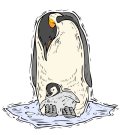
During this period, the males huddle together for warmth and for protection from the howling winds (which can reach 100 mph in a storm). Emperor penguins are specially adapted to survive these harsh conditions as their body size and shape gives them a lower 'surface-to-volume' ratio and their flippers are much smaller proportionally than any other penguin. All penguins have developed a heat-exchange system of blood vessels in their flippers and legs so that returning venous blood is warmed up by the outgoing arterial blood. Emperors also have an exceptional heat-exchange system in their nasal passages, which recovers much of the heat added to the cold air they breathe in. They also have long, double-layered, high-density feathers, which cover their legs.
Crowding closely together saves heat loss and each penguin shuffles along slowly gradually moving from the cold outer edges of the group to the warmer centre. During this time, the average temperature is around minus 4 degrees Fahreinheit (-20 degrees centigrade) but can drop to minus 40 degrees (-40C) or more and, if Papa Penguin drops the egg onto the ice or exposes it for just a few seconds, the embryo will die. At last the egg hatches and the starving parent, who will have lost about a third of his weight, still manages to feed his chick for a couple of days from a residue in his crop - all the while keeping the tiny downy chick tucked under his 'pouch' to keep warm. Timing it perfectly, Mama Penguin returns at this point and takes over the chick's care so that the male penguin can return to the feeding grounds. His fast will have lasted some 110-115 days. It is a long journey to and fro over the ice which is where the penguins' tobogganing trick comes in very handy.
Having put back his lost weight, the male returns by the end of August and both parents then take turns to feed the chick for the next three months. Because of the distance the parents have to travel over the ice, this is usually one very large meal every three to four days. However, as conditions improve, the sea ice gradually melts away, so the previously long journey to the breeding ground becomes much shorter and quicker.
By late spring, the chicks have fledged but they are still only 60% of the adult's weight, the lowest of any penguin. In early December, the young Emperor Penguin is finally at the stage when he can fend for himself. This is the most favourable time of the antarctic year, when the shore ice is melting and the antarctic summer is just beginning giving this amazing bird the best start in a life which can be as long as twenty years.
Monday, 30 May 2005
Cruelty to Animals
Topic: Nature and Our World
I believe all other creatures have as much right to live as we do. Last Thursday evening, as we left my daughter's house; I saw a frog in the middle of the road I was about to turn into. Along came a car - oh, no - straight over it. Amazingly it hopped again so, disregarding the pouring rain, I leapt out of the car, scooped up my prince in disguise and carried him to safety. This afternoon, I spotted a large bird in the garden, a baby rook! There is a nest in the huge walnut tree in next door's garden. The rooks had been dive-bombing a cat earlier in the morning so, that was the reason, a fledgling in distress. Out I went. He fluttered up and down the garden and cowered in a corner. I picked him up easily; he felt cold and a bit thin. Nevertheless, I tried my best and threw it up into the air - if he landed on a branch, he could be fed by his anxious parents and might succeed in flying properly.
So, you can imagine my indignation when I read what had happened to a poor
cat. Shot in the chest with an airgun and severely kicked! What harm had that animal ever done to the thug who attacked her! Earlier in the year, there was a spate of attacks against cats in Bognor Regis and Chichester. One poor creature even had its tail cut off. What makes people do such cruel things to trusting and friendly animals? I can understand, but not condone, a young child pulling off a spider's legs or throwing stones at squirrels and birds; they need to be taught to respect nature. But an adult or sub-adult shooting a pet cat for no reason at all is the lowest of the low!
Friday, 20 May 2005
Energy for Life
Topic: Nature and Our World
Did you watch last night's "Question Time" from Edinburgh on BBC
1? One of the questions was, "Would the panellists prefer either a wind turbine or a nuclear power station in their back yard"? I wonder what people in this country said when the first windmills were being built in the 12th century for milling grain? Were they a 'blot on the landscape' in the middle ages? Now we think that windmills are a picturesque addition to the landscape, like our own local mill up on
Halnaker Hill, near Chichester. Some windmills have been lovingly restored to full working order such as
High Salvington Mill near Worthing. I remember visiting that windmill with my sister in my late teens. It was being used as a tea room and we 'partook of the refreshments'. We were the only customers late that afternoon and the gentleman in charge was friendly and chatty. We admired the, at the time, somewhat derelict mill and asked how old it was. He invited us behind the scenes on a little tour of the building and showed us the old mill stone. I remember being invited to pull on a rope - he then told me that I had just lifted one ton! I was
very impressed.
To get back to the question of wind turbines versus nuclear power stations; where practicable, I would choose the wind turbine generator every time. They are not as picturesque as windmills but, who cares! Initially, they are much cheaper to install and maintain then building a large nuclear power station and the amount of pollution and greenhouse gases they produce is negligible. Okay, so nuclear power can be very cheap to produce and creates no air pollution, until there is an accidental release of radioactivity, such as the Chernobyl disaster in 1986! Then there is the problem of the disposal of dangerous radioactive by-products, which can remain hazardous for thousands of years. Until, and if, we learn to properly harness nuclear fusion (combining atoms) instead of nuclear fission (splitting atoms), this will be the main drawback to nuclear power.
This debate raises a deeper concern. From the time of the Industrial Revolution, people in Europe have relied on fossil fuels such as coal and petroleum to produce energy. In many third world countries, they still rely on wood to cook and to keep warm. This unrelenting demand for natural and fossil fuels is stretching the planet's resources and alternative sources of energy must be found, and soon. One solution, is the harnessing of wind power, together with solar power and wave power. As long as our solar system exists, we shall have waves and winds and solar power, free energy to use without adding to the greenhouse effect we hear so much about. Since the advent of the car, the worldwide demand for petroleum has been steadily increasing and this rate of demand cannot be sustained for many more years. Today's oil fields will, eventually, run dry and humanity will be forced to find an alternative solution; perhaps electric or hybrid cars with petrol motors kicking in on motorways to start with. Research is also being undertaken into producing a car with
hydrogen-powered fuel cells. This would be clean and sustainable, when they find a way of reducing the cost. Perhaps, one day, they will discover how to harness
gravity or magnetism, who knows!
As a small child, I can remember asking my sister, Pauline, where
petroleum and petrol came from. I knew it came from oil wells, but how had it got in the ground in the first place? At the time, her answer sounded quite plausible to me - dinosaur wee! Well, they were huge creatures and must have had huge bladders! Actually, the natural process which forms petroleum still continues today, as it was formed from plants and animals living in the warm seas that covered the earth millions of years ago. As they died, they piled up on the sea bottom, sunk under their own weight into the sea floor, eventually to be covered by tons of sand and mud. Under pressure, and over millions of years, this dead sludge gradually turned into dark liquid trapped in the pores of the earth. Some found its way into 'pockets', forming today's oil fields and, occasionally, oil rose to the surface creating sticky tar 'lakes', death traps for many prehistoric creatures. Early man made use of it to make torches, waterproof baskets or the seams of ancient ships. The Ancient Egyptians used bitumen to preserve their mummies; the Chinese used petroleum for heating and Red Indians used it as paint, fuel and medicine. Today, petroleum is refined or distilled to make petrol, paraffin, lubricants, waxes and asphalt. But the rate we use it up is much faster than the time it takes the earth to produce it and the truth is that it will probably run out in a hundred more years.
Unfortunately, the refinement and burning of fossil fuels, such as coal and oil, releases sulphur dioxide and nitrogen oxide into the air, impurities which are a major cause of acid rain, together with large amounts of greenhouse gases, such as carbon monoxide. This is affecting our climate, our forests, our seas and our lakes. Society is irresponsible, too; we waste an enormous amount of energy - just look at all those neon advertisements signs you see in London or New York! Our street lights are wasteful, directing light in all directions instead of straight to the ground where it is needed.
All new houses should be better insulated and should incorporate solar roof panels. Why not have them on cars, too - they could boost the battery and perhaps even power a car for short urban shopping trips. More research should also go into developing a viable solar-powered oven for those third world communities currently relying on wood or camel dung for essential cooking purposes. We should be doing all this
now - not leaving the problem for our great-grand children. If we don't do something about the pollution to the environment, about deforestation and over-fishing, the harm we are doing to our beautiful planet, to its bio-diversity and, ultimately, to humanity itself, could be permanent and lethal.
Monday, 16 May 2005
Amazing Animals: The Camel
(No. 2 in my series)
Topic: Nature and Our World
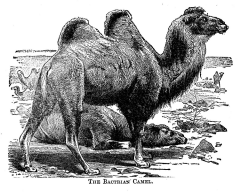
I was quite young when I had my first encounter with a camel. My sister, Janine, had taken me to
London Zoo and we spotted the 'Camel Ride' - I eagerly joined the long queue. Oh, yes, please... I want to wait, I told my sister. It was a huge creature, a Bactrian Camel with two humps, thick, long shaggy ruddy-brown hair and enormous feet. The 'seat' was one of those contraptions with two benches suspended laterally and seating several children on each side of the camel's humps. It was a very long wait but finally I got to the front of the queue, standing eagerly by the steps ready to climb up onto the bench seat. At last the camel returned and its passengers climbed down. I can still feel my trembling excitement when I was suddenly whisked up into the air by the Keeper and, because I was so small, placed not on the bench seat, but on the camel's neck! I could see where we were going; I could touch its hair. I was riding a camel!
Many years' later, when I was twenty-three, I visited the
Land of the Pharaohs and had my second encounter with a camel - an Arabian camel, this time, with one hump. Its days were taken up patiently transporting countless tourists the short distance to that crumbling wonder of the ancient world,
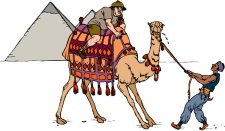
the
Great Pyramid of Khufu (Greek name Cheops). Never having had much to do with horses, I took to riding the camel straight away. The camels are taught to kneel down, as it much easier to climb on. However, I knew that once up there, you had to be very careful when they got up! You see, they raise their back legs first and then, when they kneel down again, they go down on their front knees first so, I made sure I was leaning right back. (I did see one tourist fall off!) I also knew, probably from seeing that epic film, "
Lawrence of Arabia", that you should hook your right foot behind your left knee - it certainly felt much more secure. The camel has a strange, rather pleasant, swaying gait when walking because its left front and back legs move together followed by its right front and back legs - no wonder it was called the 'ship of the desert'!
The two-humped Bactrian Camel (
Camelus bactrianus)is found throughout Asia, mainly in Mongolia and in China. A very small number of protected wild herds still roam the grassy Steppes and the Gobi Desert. Their extra long hair protects them from the extremes of temperature and they have shorter legs and thicker bodies than the one-humped Arabian camel (
Camelus dromedarius), which is found in the Middle East and in Africa. There are no wild herds of Arabian camels in North Africa as, when the animal was first domesticated some 5,000 years ago, their wild cousins died out.
And, yes, they are the most amazing of creatures; both types of camels are perfectly adapted to the desert environment. They carry a reserve of fat in their humps and can go for long periods without water, particularly if leafy plants are available. Although they are not true ruminants, their stomachs are divided into three sections and they swallow food whole then regurgitate it later to chew the cud. Camels don't pant and they perspire very little as they have a large body temperature range, which can fluctuate between 93?F (34?C) in the early hours of the morning to 105?F (41?C) or more by midday, without causing them distress. They just 'cool off' overnight when the desert temperature drops. This unique 'body thermostat' allows them to conserve body fluids and avoid unnecessary water loss. In addition, their kidneys can concentrate their urine, which can become as thick as syrup and twice as salty as seawater! They also extract fluid from their faeces and their pellets are so dry they can be used immediately for fuel.
Camels can go 5-7 days with little or no food and water and can easily lose a quarter of their body weight or more without suffering any consequences. Blood plasma volume is maintained as, when necessary, water stored in body fat and other tissues can be extracted. This lost water can be rapidly replaced and a large animal can drink as much as 100 litres/21 gallons of water, even brackish water, in ten minutes. This would cause severe problems in other animals, but the camel's unique metabolism enables it to store the water in its bloodstream. Camels are the only mammals with oval (instead of circular) red blood cells. This adaptation allows the red blood cells to continue to circulate if the blood thickens and to expand and not rupture when the camel takes in large quantities of water.
Some other physical characteristics which allow camels to survive so well in arid desert conditions include a double row of beautiful long eyelashes that protect their eyes from wind-blown sand; small ears lined with fine hairs, also to keep out sand; nostrils that can be closed; thick lips and 34 sharp teeth to eat coarse, thorny desert plants; and two-toed feet which have vestigial hoofs that look like nails and a broad calloused pad to walk on hot sand. And, I promise you, desert sand can get
very hot indeed around midday,
never step on it barefooted as I once did when I came out of a shrine carrying my sandals!
Certainly, without the camel, the desert peoples would never have flourished. They provide transport, shade, milk, meat, wool and hides - the
Bedouin call it,
Ata Allah, (God's gift). Camel milk is actually highly nutritious and lower in fat and lactose than milk from a dairy cow. The much-prized riding or racing camel, the equivalent of a pedigree racing horse, is called the Dromedary.
Camels live for up to 40 years and their gestation period is 13 months, so females only breed every two years. Calves weigh about 90 pounds at birth and take about five years to mature. All the Camelidae family evolved in North America, where they eventually became extinct approximately 12,000 years ago. However, before the ice ages, some of the early ancestral camels crossed the Alaskan land bridge (Bering Strait) to Asia and others the Panama land connection to South America. Therefore the Bactrian and Arabian camels are closely related to the
South American Llama and alpaca, vicuna and guanacos. All the South American camelids can be interbred and selective breeding can greatly improve the quality of their wool. Likewise, the Dromedary and Bactrian camels are very similar to each other and can be
crossbred to produce faster, stronger hybreds. All hybred offspring are fertile.
Friday, 22 April 2005
A Dying World?
Topic: Nature and Our World
 |
Earthrise from Moon Orbit |
|---|
Today is "Earth Day". So, perhaps it is my mood which led me to choose the poem by Alfred Lord Tennyson,"All Things will Die".
We hear that so many life forms are about to become extinct. Did you know that some 1,130 species of mammals and 1,183 species of birds are likely to disappear within the next thirty years? And what about the animals and plants in the rain forests which will be destroyed before we have had a chance to discover and catalogue them?
Scientists from London?s Natural History Museum, the Zoological Society of London and Nottingham University are working together to build a
Frozen Ark in which they are storing tissue samples from endangered species. Perhaps scientists of the future will be able to 're-create' a lost species.
But at the same time, we hear that
Antarctic glaciers are melting at an unprecedented rate and that, if this is not halted, sea levels will gradually begin to rise. The Arctic ice is also shrinking and, eventually, the flow of cold, fresh meltwater could switch off the
Gulf Stream and create a new ice-age in Europe. All a probable result of global warming caused by greenhouse gas emissions, which are on the increase due to world-wide pollution. In addition, we cut down the world's forests, we overfish the oceans, destroy the sea floor with trawl nets and pollute the seas with poisonous chemicals. Dead seas, no trees, no oxygen.
What sort of world will our great-grand children inherit? Will there be enough land above sea level to live on? Will there be any life left in the sea? Will our rich bio-diversity have been lost for ever?
Perhaps I am being too melodramatic? But, this generation must learn to take care of our Earth - after all, it is the only one we have and it is our children's inheritance that we are slowly destroying.
| All Things will Die |
|---|
Clearly the blue river chimes in its flowing
Under my eye;
Warmly and broadly the south winds are blowing
Over the sky.
One after another the white clouds are fleeting;
Every heart this May morning in joyance is beating
Full merrily;
Yet all things must die.
The stream will cease to flow;
The wind will cease to blow;
The clouds will cease to fleet;
The heart will cease to beat;
For all things must die.
All things must die.
Spring will come never more.
O, vanity!
Death waits at the door.
See! our friends are all forsaking
The wine and the merrymaking.
We are call?d-we must go.
Laid low, very low,
In the dark we must lie.
The merry glees are still;
The voice of the bird
Shall no more be heard,
Nor the wind on the hill.
O, misery!
Hark! death is calling
While I speak to ye,
The jaw is falling,
The red cheek paling,
The strong limbs failing;
Ice with the warm blood mixing;
The eyeballs fixing.
Nine times goes the passing bell:
Ye merry souls, farewell.
The old earth
Had a birth,
As all men know,
Long ago.
And the old earth must die.
So let the warm winds range,
And the blue wave beat the shore;
For even and morn
Ye will never see
Thro? eternity.
All things were born.
Ye will come never more,
For all things must die.
|
by Alfred Lord Tennyson | |
Sunday, 17 April 2005
Amazing Animals: Woodlice
Topic: Nature and Our World
This morning, I was coming out of the garage into our porch when I spotted a woodlouse on the brick wall by the front door. It was long dead of course, a desiccated shell, but it made me think of the first time I noticed something unusual about these little beasties. We hadn't been married much more than a year and we were moving into our first house in Worthing. There was a rotten tree stump in the garden, swarming with woodlice, and we were trying to clear it away. One large individual woodlouse fell on its back and froze, with its legs sticking up; it had a white patch on its underside. I bent down to look closer - it was a sort of greyish-white sack. I touched it with a tiny twiglet... A movement, a minute tear, and a horde of tiny baby woodlice started to appear one by one, hundreds, it seemed. The adult was completely motionless. Had I killed it, I wondered?
Woodlice are very ancient creatures which remind me of fossilised trilobites. There are many different species of these amazing little animals worldwide, but only 37 live in the UK. The ones most often seen in our British gardens are the common rough woodlouse (
Porcellio scaber), the common shiny woodlouse (
Oniscus asellus) and the common pillbug (
Armadillidium vulgare). All British woodlice are vegetarians and nocturnal in habit. They like living in damp places, under rotting wood, or vegetation. They actually help to recycle waste by eating decaying wood and plants and thereby improve your garden soil! They have a head, thorax and an abdomen; two large antenna (and two tiny vestigial ones); two compound eyes; seven pairs of jointed legs (one for each of the seven thoracic segments), and an exoskeleton. They breathe through gills on their legs and also have 'pseudo-lungs' which can be seen as white patches at the back of the underside. These allow gases to diffuse in and out through a pore which can't be closed. So Woody needs a damp environment or he will soon dry out.
Woodlice are actually
Crustacea and they belong to a group of Arthropods called
Isopoda, a class of animals usually found living in water. Crustaceans are hard-shelled creatures - which include lobsters, crabs, shrimps, prawns, water fleas and barnacles - strange relatives for a little creature found in all our gardens. (Incidentally, trilobites were also Arthropods.)
Woodlice are usually a dark grey colour but if you find one that is half-pale, then it has just moulted. First the back half is shed and then the front half. This process allows them to grow a little before the new shell hardens. They usually live for about two years.
The 'sack' I had first seen all those years ago is, in fact, a brood pouch called a "marsupium" in which the eggs are stored for several weeks until they hatch. The new babies only have six pairs of legs and are very vulnerable to desiccation so, at this stage, they stay in their mother's pouch for several days until they moult for the first time and get their seventh pair of legs. Most woodlice breed once a year and the larger the female, the more eggs she is likely to produce.
[For further information on Woodlice, look here and here]
Newer | Latest | Older

 Sturgeon belong to the order of Acipenseriforms, family Acipenseridae. There are twenty-seven living species - all in the Northern Hemisphere and all in serious decline. According to WildAid, only three of the species is not critically endangered or endangered due to the demand for caviar. This is a sad state of affairs as, together with their cousins, the Paddlefish, Sturgeon are the only survivors of an ancient group of fishes from the Upper Cretaceous period (135-200 million years ago) which, with five extinct species, formed the infraclass Chondostrei. These ancient 'living fish fossils' are, therefore, one of the oldest vertebrates on Earth. The sturgeon is also the largest of freshwater fishes and the longest lived. The greatest recorded age was 154 years for a Lake sturgeon caught in 1953.
Sturgeon belong to the order of Acipenseriforms, family Acipenseridae. There are twenty-seven living species - all in the Northern Hemisphere and all in serious decline. According to WildAid, only three of the species is not critically endangered or endangered due to the demand for caviar. This is a sad state of affairs as, together with their cousins, the Paddlefish, Sturgeon are the only survivors of an ancient group of fishes from the Upper Cretaceous period (135-200 million years ago) which, with five extinct species, formed the infraclass Chondostrei. These ancient 'living fish fossils' are, therefore, one of the oldest vertebrates on Earth. The sturgeon is also the largest of freshwater fishes and the longest lived. The greatest recorded age was 154 years for a Lake sturgeon caught in 1953. Some Sturgeon live in the sea but migrate to freshwater to breed (anadromous) and others live entirely in freshwater. These primitive fish have an almost entirely cartilaginous endoskeleton with a flexible cartilaginous rod called a notochord running down the back instead of a backbone. They have heavy tube-like bodies with five rows of large bony plates or scutes along their sides instead of scales and, in common with many other primitive fish, they have an asymmetrical (heterocercal) caudal fin or tail.
Some Sturgeon live in the sea but migrate to freshwater to breed (anadromous) and others live entirely in freshwater. These primitive fish have an almost entirely cartilaginous endoskeleton with a flexible cartilaginous rod called a notochord running down the back instead of a backbone. They have heavy tube-like bodies with five rows of large bony plates or scutes along their sides instead of scales and, in common with many other primitive fish, they have an asymmetrical (heterocercal) caudal fin or tail. 


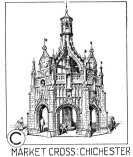

 I've always been fascinated by that most marine of birds, the
I've always been fascinated by that most marine of birds, the  During this period, the males huddle together for warmth and for protection from the howling winds (which can reach 100 mph in a storm). Emperor penguins are specially adapted to survive these harsh conditions as their body size and shape gives them a lower 'surface-to-volume' ratio and their flippers are much smaller proportionally than any other penguin. All penguins have developed a heat-exchange system of blood vessels in their flippers and legs so that returning venous blood is warmed up by the outgoing arterial blood. Emperors also have an exceptional heat-exchange system in their nasal passages, which recovers much of the heat added to the cold air they breathe in. They also have long, double-layered, high-density feathers, which cover their legs.
During this period, the males huddle together for warmth and for protection from the howling winds (which can reach 100 mph in a storm). Emperor penguins are specially adapted to survive these harsh conditions as their body size and shape gives them a lower 'surface-to-volume' ratio and their flippers are much smaller proportionally than any other penguin. All penguins have developed a heat-exchange system of blood vessels in their flippers and legs so that returning venous blood is warmed up by the outgoing arterial blood. Emperors also have an exceptional heat-exchange system in their nasal passages, which recovers much of the heat added to the cold air they breathe in. They also have long, double-layered, high-density feathers, which cover their legs.  I was quite young when I had my first encounter with a camel. My sister, Janine, had taken me to
I was quite young when I had my first encounter with a camel. My sister, Janine, had taken me to  the
the 